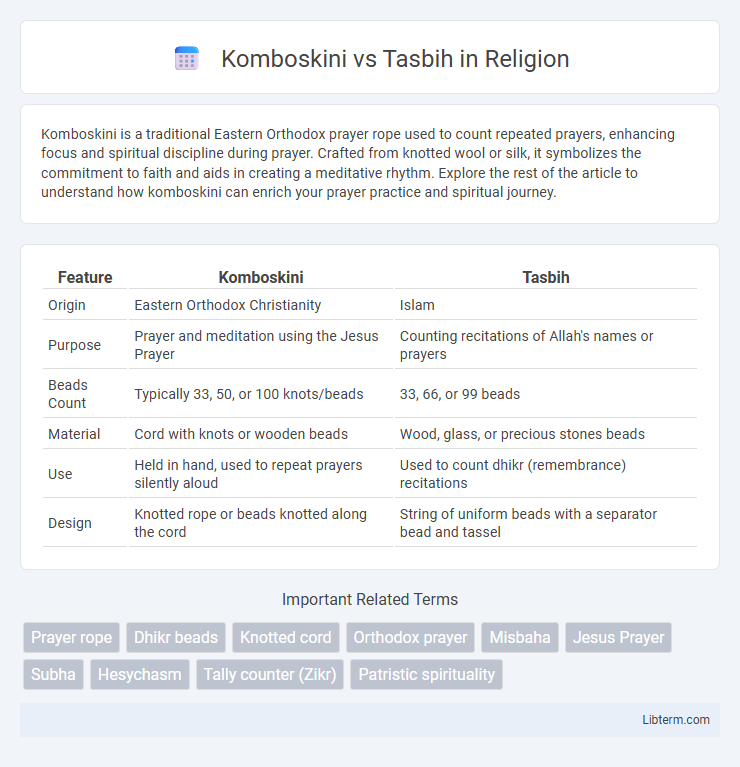Komboskini is a traditional Eastern Orthodox prayer rope used to count repeated prayers, enhancing focus and spiritual discipline during prayer. Crafted from knotted wool or silk, it symbolizes the commitment to faith and aids in creating a meditative rhythm. Explore the rest of the article to understand how komboskini can enrich your prayer practice and spiritual journey.
Table of Comparison
| Feature | Komboskini | Tasbih |
|---|---|---|
| Origin | Eastern Orthodox Christianity | Islam |
| Purpose | Prayer and meditation using the Jesus Prayer | Counting recitations of Allah's names or prayers |
| Beads Count | Typically 33, 50, or 100 knots/beads | 33, 66, or 99 beads |
| Material | Cord with knots or wooden beads | Wood, glass, or precious stones beads |
| Use | Held in hand, used to repeat prayers silently aloud | Used to count dhikr (remembrance) recitations |
| Design | Knotted rope or beads knotted along the cord | String of uniform beads with a separator bead and tassel |
Introduction to Komboskini and Tasbih
Komboskini and Tasbih are traditional prayer beads used in Eastern Orthodox Christianity and Islam, respectively, for counting prayers and meditative recitations. Komboskini typically consists of 33 or 100 knots made from wool or silk, symbolizing the Jesus Prayer, while Tasbih usually features 99 or 33 beads corresponding to the 99 Names of Allah. Both serve as tactile aids in spiritual practice, enhancing focus and devotion during repetitive prayer rituals.
Historical Origins and Development
Komboskini, traditionally used in Eastern Orthodox Christianity, originated in the Byzantine Empire as a prayer rope with knots symbolizing continuous prayer, evolving from early Christian monastic practices. Tasbih, prevalent in Islamic culture, developed from the misbaha or subha, a string of beads used to count the recitation of Allah's names, with roots tracing back to the earliest Islamic centuries. Both objects reflect distinct theological frameworks and ritual functions shaped by their respective religious histories and cultural contexts.
Design and Physical Characteristics
Komboskini typically features a knotted rope design made from wool or cotton, with 33 or 100 knots spaced evenly to aid in prayer counting, reflecting its Eastern Orthodox origins. Tasbih beads, often crafted from materials like wood, glass, or precious stones, consist of 33, 66, or 99 beads strung on a cord, sometimes accented with a tassel or marker beads for easy cognitive separation. The tactile experience differs as Komboskini's knots provide a textured grip, while Tasbih beads offer smooth, rounded surfaces, catering to distinct cultural and religious rituals.
Materials Used in Komboskini and Tasbih
Komboskini beads are traditionally made from wool, silk, or cotton threads, often knotted by hand to create a tactile surface ideal for prayer. Tasbih beads commonly use materials like wood, amber, glass, or semi-precious stones, offering durability and a polished finish for easier manipulation during recitation. The natural fibers in komboskini provide a softer feel, while tasbih's solid beads emphasize longevity and varied aesthetic appeal.
Symbolic Meanings and Religious Significance
Komboskini and Tasbih both serve as prayer beads, symbolizing spiritual focus and devotion within Eastern Orthodox Christianity and Islam, respectively. Komboskini, made of knotted wool or silk, represents the unity of the believer with Christ and the continuous repetition of the Jesus Prayer, emphasizing humility and repentance. Tasbih, typically composed of 99 or 33 beads, signifies the 99 names of Allah, facilitating dhikr (remembrance of God) and reinforcing a Muslim's connection to divine attributes and spiritual discipline.
Prayer Practices and Methods of Use
Komboskini and Tasbih are both prayer tools used in Eastern Orthodox and Islamic traditions, respectively, to aid in repetitive recitations of prayers or divine names. The Komboskini consists of knotted cords, typically 33 or 100 knots, each representing a prayer, and is used by sliding knots through fingers while reciting the Jesus Prayer. In contrast, Tasbih often features 33, 66, or 99 beads strung together, enabling practitioners to count dhikr phrases like "Subhanallah" during Islamic devotional acts.
Role in Orthodox Christianity vs Islam
Komboskini, a knotted prayer rope, serves as a vital spiritual tool in Orthodox Christianity, aiding in the repetition of the Jesus Prayer to cultivate inner peace and divine connection. In contrast, the Tasbih, a string of beads commonly used in Islam, facilitates the recitation of specific phrases praising Allah, such as SubhanAllah, Alhamdulillah, and Allahu Akbar, reinforcing faith and mindfulness. Both instruments emphasize repetitive prayer but reflect distinct theological traditions and devotional practices central to Orthodox Christian and Islamic worship.
Cultural Influence and Regional Variations
Komboskini and Tasbih beads both serve as prayer tools rooted in Orthodox Christianity and Islamic traditions, respectively, exhibiting distinct cultural influences and regional variations. Komboskini, prevalent in Eastern Orthodox countries like Greece and Russia, reflects Byzantine spiritual heritage with its wool or silk braided cords symbolizing monastic discipline. Tasbih, commonly used across Middle Eastern and South Asian Islamic cultures, often features 33 or 99 beads representing the names of Allah, highlighting regional craftsmanship through materials like wood, amber, or gemstones.
Modern Adaptations and Contemporary Use
Komboskini and Tasbih both serve as prayer beads but have seen distinct modern adaptations across different cultures. Komboskini, traditionally used in Eastern Orthodox Christianity, now incorporates durable materials like silicone and magnetic beads for enhanced portability and durability. Tasbih, prominent in Islamic practice, often features digital counters and ergonomic designs to facilitate longer, more precise recitations in contemporary worship settings.
Choosing Between Komboskini and Tasbih
Choosing between Komboskini and Tasbih depends on cultural tradition and personal preference in prayer practice. Komboskini, used primarily in Eastern Orthodox Christianity, consists of knotted cords designed for repetitive prayers like the Jesus Prayer. Tasbih, commonly used in Islamic worship, features a string of beads, typically 33 or 99, to count recitations of divine names or phrases during dhikr rituals.
Komboskini Infographic

 libterm.com
libterm.com